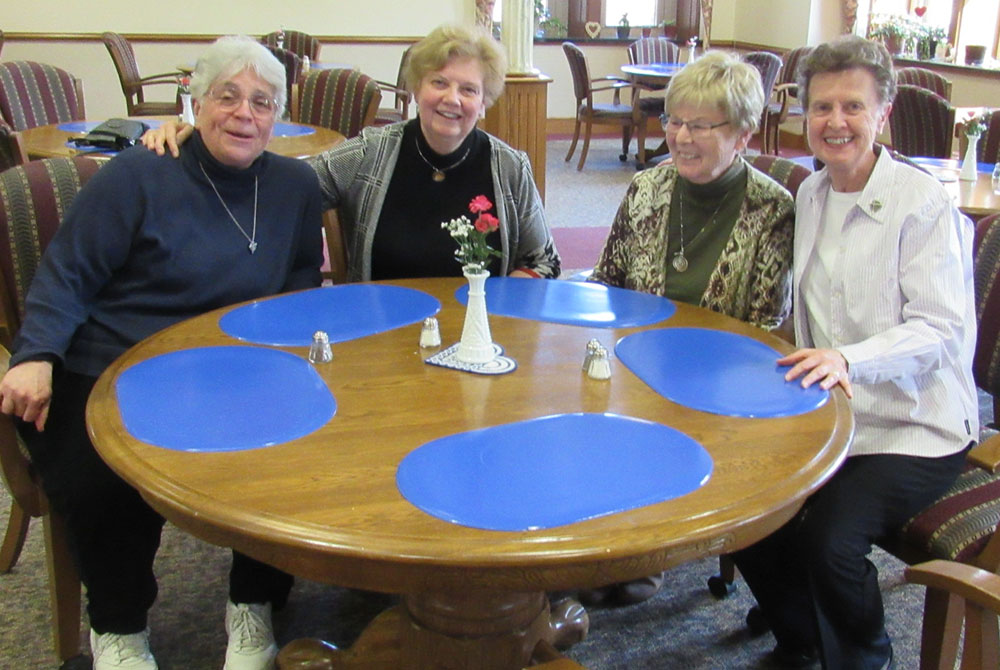
Sr. Rose Reda, left, with former Sisters of St. Joseph Mary Jo Dagney and Cathy O'Brien, and Sr. Marjorie Lawless, at the St. Joseph motherhouse in Chestnut Hill, Philadelphia (Elizabeth Eisenstadt Evans)
In the late 1960s, when Cathy Stadler and Marjorie Lawless entered the community of the Sisters of St. Joseph, they were 19 and 20, respectively. "We always felt a little older than everyone else, just because we waited one or two years before entering," said Lawless, now Sister Marjorie. "We did so many things together, including some extra studies. It was a way of bonding."
But 20 years later, after what she described as a "real war with God," Stadler, now Cathy O'Brien, decided she could no longer stay. "The only conclusion I could come to was I was just being called to something else. I had no idea what it was. No idea at all. But I felt I had to leave."
"I wanted to support her in her choice, because it was her choice," recalled her friend Lawless later.
It was an emotional moment on an afternoon peppered with memories of a community life that in some ways is long gone — and in others has expanded to embrace the fellowship of women who were once Sisters of St. Joseph, and are no longer.
O'Brien and Lawless met at the Motherhouse of the Sisters of St. Joseph of Philadelphia on a Wednesday in February, along with Sister of St. Joseph Rose Reda and former sister Mary Jo Dagney, to talk about a topic that gets little formal attention but is an everyday reality: ongoing friendships with women who have left the religious communities they once called home.
In a chapel off the foyer of the imposing convent that sits next to Philadelphia's Chestnut Hill College, the school founded by the order, O'Brien and Lawless joined Reda and Dagney, now all women in their 60s and 70s, to reminisce about shared history, spiritual roots and communal life that bonded them.
There was much laughter — and the occasional sympathetic tear.
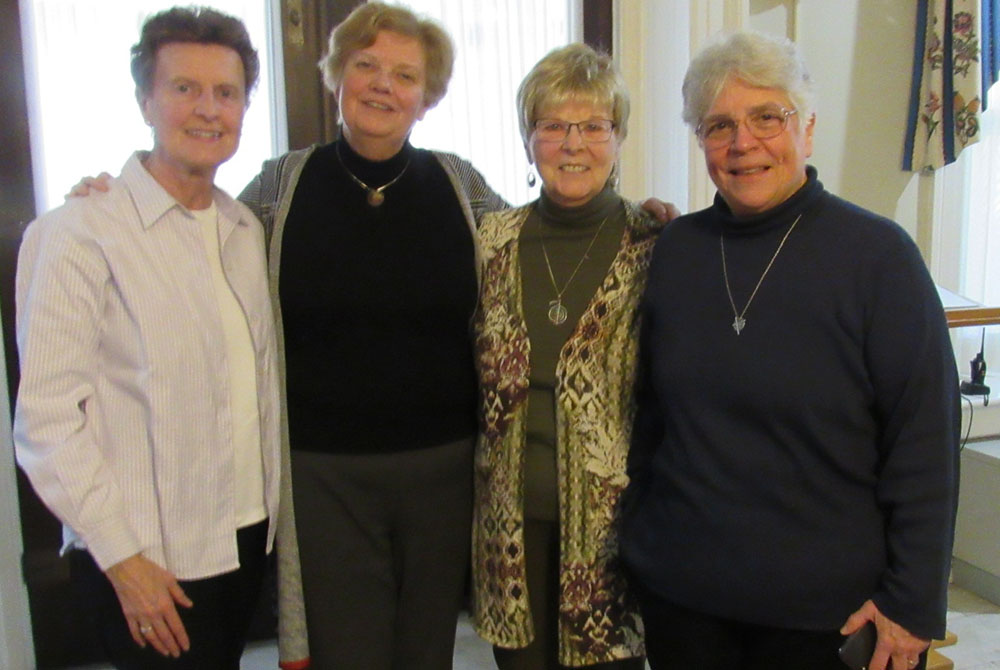
Sister of St. Joseph Marjorie Lawless, left, prepares to say goodbye to former sisters Mary Jo Dagney and Cathy O'Brien, and Sr. Rose Reda, in the front hall of the Sisters of St. Joseph motherhouse in Chestnut Hill, Philadelphia. (Elizabeth Eisenstadt Evans)
Reda and Dagney met initially while Dagney was a student at Chestnut Hill. They really bonded later when Dagney, a geriatric nurse, returned to the area and moved in with Reda and a group of other sisters.
"Every night," recalled Dagney fondly, "we would get together and do something: play Rummikub, canasta and pinochle."
When she eventually left the community, she said, it wasn't because she had negative feelings or was in bad shape psychologically. "I just knew it was time to do something different. It sounds trite, and I don't mean it to be, but I knew I had to do something else."
Board and card games. In a way, that's what led to Reda and Dagney's reunion. "Some of us who had played canasta together are still in this building," said Reda, IT coordinator for the sisters. "Mary Jo wasn't far away. Periodically we would connect. I don't know who brought it up initially, but we said, 'we should get together and play.' "
So, they did. Every month, Reda, two other St. Joseph sisters, Dagney's companion Harry, another friend and a former priest gather at Dagney's apartment for dinner and cards. "It's social, it's fun, but there's also a depth to the relationship that exists between us."
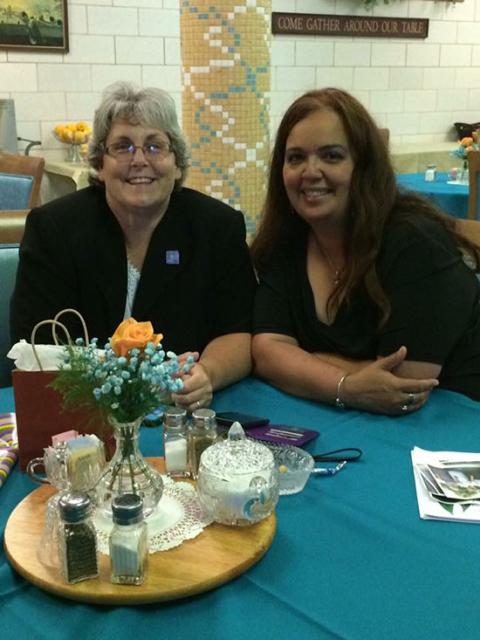
Sr. Debbie Borneman, left, of the Sisters of Sts. Cyril and Methodius, enjoys a moment with her friend, former sister Rosa Gouveia, at Borneman's 20th Jubilee celebration in Danville, Pennsylvania. (Provided photo)
The decision to depart
As in a marriage, there are no simple answers on why some members of religious communities choose to depart, said Deborah Marie Borneman, a Sister of Sts. Cyril and Methodius and director of mission integration for the National Religious Vocation Conference. Borneman entered religious life in 1994, well after the post-Vatican II exodus.
"Sometimes there's really no one to blame, the reason someone came to religious life isn't necessarily why they stay," she wrote in an email. "It's really a daily 'yes' to the vows and yet, sometimes good people decided to leave and seek dispensation from their vows for good reasons."
"No one comes down the aisle on the day of profession with the mindset that they should leave," said Borneman, suggesting that there is "great freedom in knowing that you can actually leave religious life, so each day is another opportunity to respond to God's call with a 'yes.' " In fact, she added, if a person leaves during the formation process, it means that process is doing what it was meant to do.
Attempts on the part of congregations to reconnect with former sisters were not part of a formal movement, said Borneman.
A recent vocation conference study cited by Borneman found that, of the more than 8,000 women and men who chose to enter and leave religious life between 2003 and 2018, the most common time to depart was during the first part of the vocation discernment and formation process as a candidate or a postulant. Only 7% leave after final vows, she said.
That perspective on vocation is quite different from the one prevalent before the reforms of the 1960s, said La Salle University religion professor Margaret McGuinness. "In general, you would leave under cover of darkness, both literally and figuratively. All of a sudden, you'd be gone. Prior to the mid-'60s, there was a stigma attached to leaving."
In the era before Vatican II, said Sr. Ellen Dauwer, director of the Religious Formation Conference, women never got a chance to say goodbye. "It's much healthier now. Relationships between people who have left and people who remain are a lot freer now. In the past they were not encouraged."
A lot of former members of Dauwer's community, the Sisters of Charity of St. Elizabeth in Convent Station, New Jersey, have become associates and remain very active in it.
When a sister decides to leave, responses among her community may vary, she said. "There's always a sadness. Sometimes people spend years struggling, then when they leave, you feel a bit of relief, because the decision was best for them."
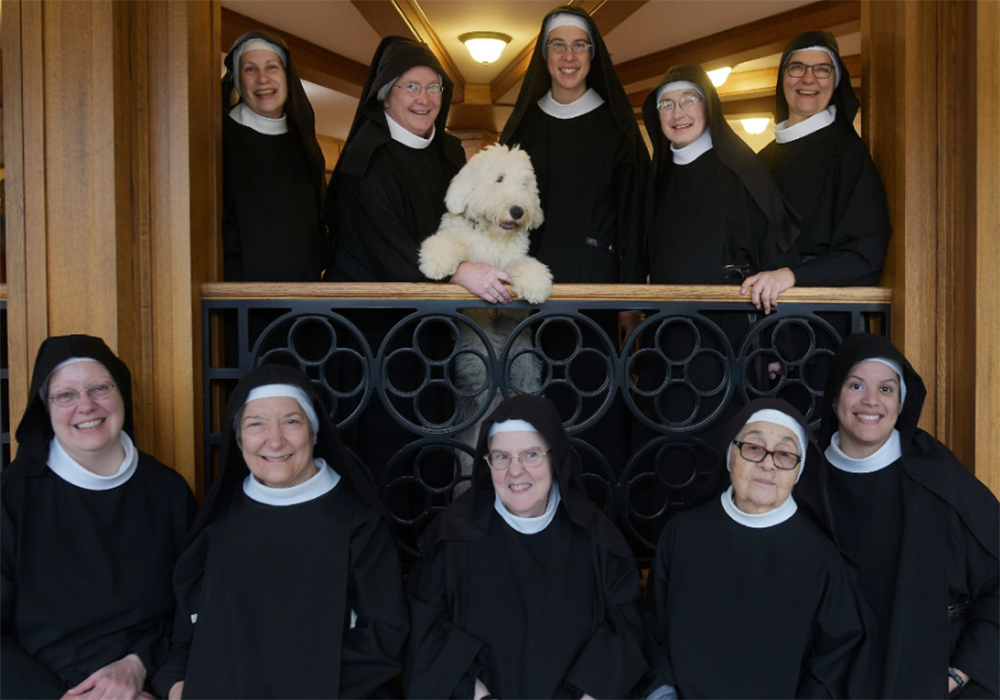
Benedictine Sr. Mary Elizabeth Kloss, far right in top row, is the prioress of St. Scholastica, a monastery in Petersham, Massachusetts. Their Old English sheepdog is named Chaeli. When a community vocation isn't a good fit, everyone eventually realizes it, Kloss said. (Christine Peterson/Telegram & Gazette, Worcester, Massachusetts)
Life after community
The reasons for leaving seem as varied as the women themselves.
Take Jan Novotka, for example.
She entered the Scranton, Pennsylvania-based community of the Sisters, Servants of the Immaculate Heart of Mary, in 1980 as a 19-year-old university student. She says she eventually found that "my spirituality had evolved in such a way that it made it impossible for me to stay. … Much as I loved the congregation — did then and still do — I didn't feel like while I was there I could find life."
Dispensed from her vows in 1999, Novotka worked as a religious educator and a parish associate before the songwriter began to crisscross the country, giving concerts and telling stories.
As the years passed, dinners with old friends from the community evolved into more formal connections with her old order. Since 2008, she's served on their EarthCare committee as well as offering retreats for them and other religious communities.
Though the first few years required a willingness to renegotiate relationships, she was blessed, she said, to stay in touch with the women who had been her companions when her spiritual life was unresolved. "They are just healthy individuals, good women."
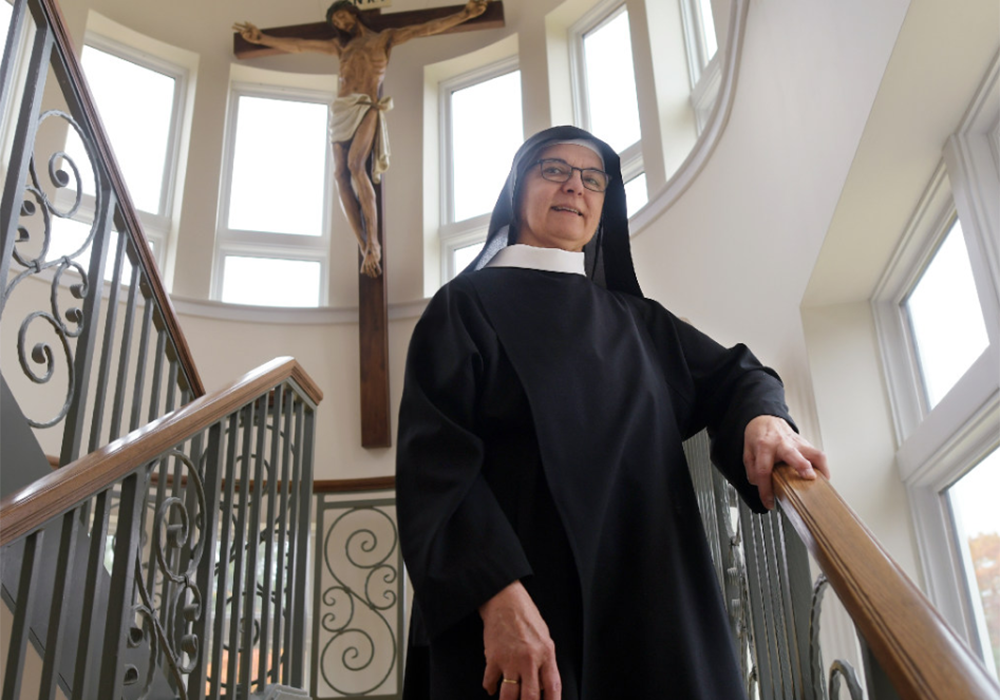
Benedictine Sr. Mary Elizabeth Kloss, on the steps of St. Scholastica Priory, is prioress of the monastery in Petersham, Massachusetts. (Christine Peterson/Telegram & Gazette, Worcester, Massachusetts)
Sometimes, said Benedictine Sr. Mary Elizabeth Kloss, longtime members hope aspiring nuns trying out community life will wake up and realize what everyone else already knows: It's not a good match. Kloss is the prioress of a small community of nuns at St. Scholastica Priory in Petersham, Massachusetts.
"We try not to be negative," said Kloss, whose own sister made the decision to leave St. Scholastica. "Some (departures) are very easy, and others tend to shake everyone. We just want to do as little harm as possible."
While some of the former nuns stay in touch, requesting prayer or sending Christmas cards, "it's kind of random," said Kloss.
Former sister Elizabeth Begley was testing her vocation with the Maryknoll sisters in the 1960s, a time in which many religious communities like her own were in flux as they navigated the changes brought about by the reforms of Vatican II. "There was such turmoil, no clear vision about what was going to change. I really was not deeply involved in the community, and felt marginalized," said Begley, who entered in 1964 and left in 1970.
But the links with her entering class — "there was a huge group entering and a huge group leaving" – were never broken, said Begley. In the 1980s, former sisters created an organization called "Full Circle," and coined the term "formers." The Maryknoll congregation provided a hospitable venue for these gatherings. "There was an openness and acceptance there that was quite ahead of its time."
As this New York Times story details, the 1980s was a time of reconciliation for other religious communities, including former priests and brothers.
Becoming part of the group "was a very healing, nourishing experience," said Begley, who added that she has long made peace with her departure, as has everyone she knows in the group. Now the group that gathers includes the Maryknoll sisters, said Begley.
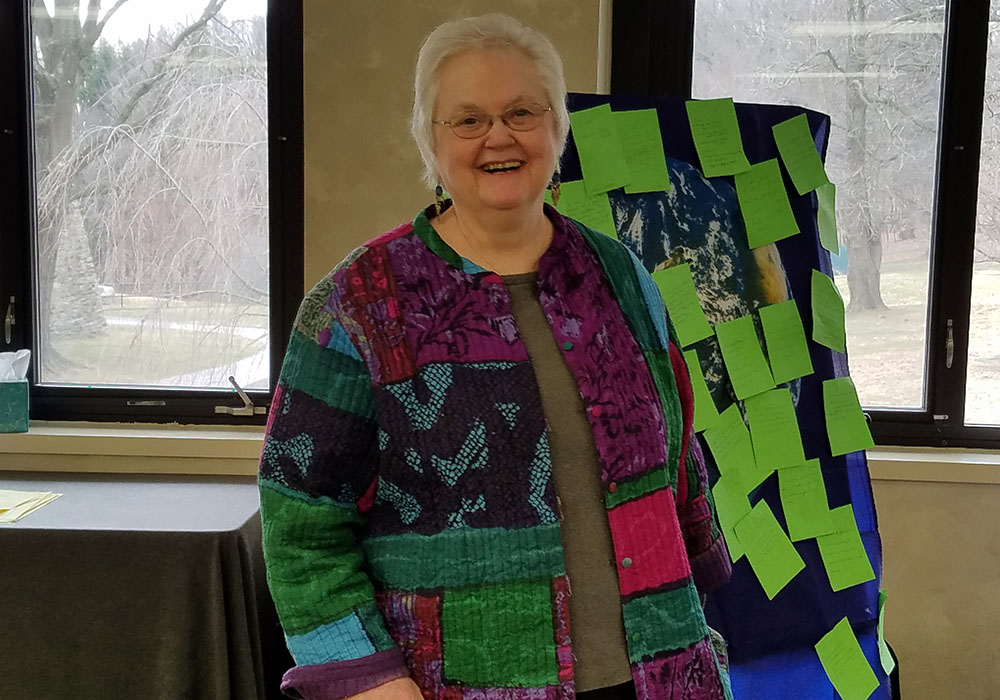
Former Maryknoll sister Beth Begley, photographed at an "Enter the Chaos" workshop held at Bon Secours Retreat and Conference Center, Marriottsville, Maryland, in February 2020 (GSR photo/Gail DeGeorge)
Hard choices
As teens when they entered the Benedictine Our Lady of Grace Monastery in Beech Grove, Indiana, Carol Falkner and Donna Fyffe were part of a group of 16 young women pursuing a vocation to religious life. "One left the next day. It wasn't a large class, then it got smaller," recalled Falkner, now Sr. Carol Falkner. "We interacted very closely."
Fyffe, who spent 31 years in the community before leaving, recalls a deepening friendship with Falkner that developed in part over their shared careers as teachers and principals. "We connected a lot about our work, and when innovative projects came up, we would do our discernment. In the beginning it was about shared ministry and our respect and liking for each other."
When she decided to leave the Benedictines in 1994, after 11 years of reflection, the decision was difficult for her and her close friends, she recalled. "It was very hard for them and for me."
At the same time, says Fyffe, it was the right choice. "I felt the call to take what I had learned from that life and become steeped in the public arena," says Fyffe, who now works exclusively with women religious as head of CommunityWorks Inc., an Indianapolis-based consulting group to religious institutions.
Her friendship with Falkner and others survived the discomforts of leaving, she said. In fact, the network of relationships has grown over the years. "We had friends separately and friends in common, and somehow we all became friends. That's what kept these friendships healthy and growing: There was plenty of freedom and latitude to have other people in your life."
"They left religious life because it wasn't their calling, but they didn't leave being a good Catholic or Christian. They didn't want to live in the community, but they have the desire to reach out to others to make the world a better place."
—Sr. Pat Stringer
From the time she was a young girl in the 1950s, Marie Hogarty dreamed of being a teacher, she said. Given that the Sisters of St. Dominic of Caldwell in Caldwell, New Jersey, were teachers, she reasoned, perhaps the best way to follow the teachings of Jesus and live out her calling would be to join the order.
Hogarty gave it a try — first as a college sophomore and then a year after graduating college, from the fall of 1969 to the spring of 1972. "One of the main reasons I left was finding out that I wasn't comfortable in a classroom, and at the time most of the Caldwell Dominicans were teachers," said the 73-year-old. The second time around, however, she really got to know fellow entrant Pat Stringer, who had served with her as a counselor at a Catholic Youth Organization camp in New Jersey a few years prior to that.
Their friendship has survived both years and distance (Stringer served in the Bahamas and the jungles of Ecuador), renewing itself over dinners when Sr. Pat was home on breaks, and more frequently when she returned for good.
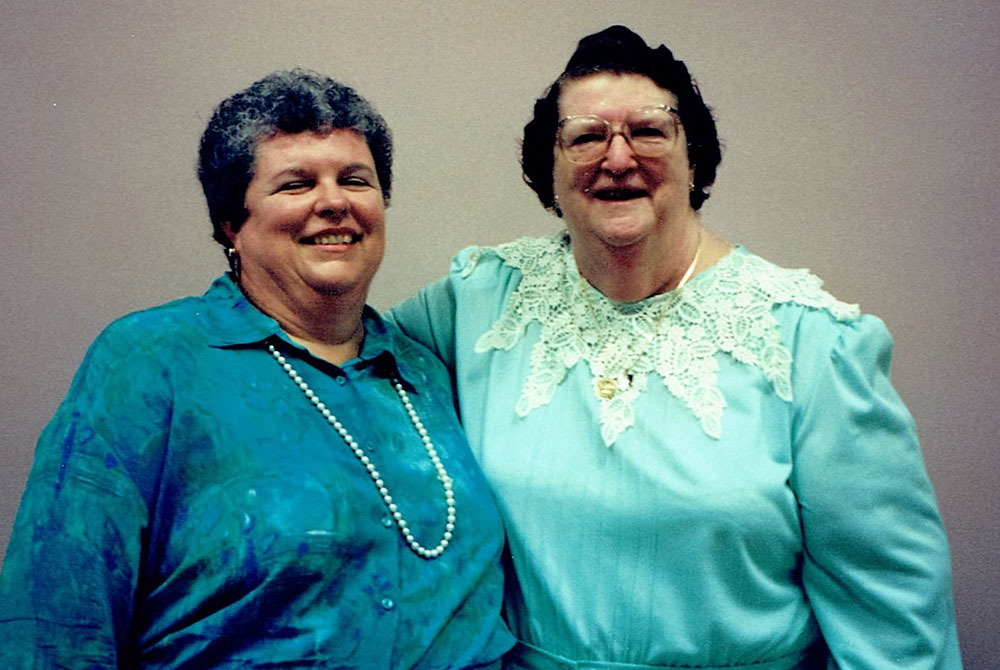
Former Dominican Sister of Caldwell Marie Hogarty, left, and her seventh-grade teacher, Sr. Lauretta Timothy, also a Dominican, at Timothy’s Golden Jubilee celebration (Provided photo)
For the past three years Stringer has been responsible for reaching out to former members, both through a newsletter and in-person gatherings. As promoter of Dominican life and mission for her community, that's part of her portfolio.
Many of the women who want to reconnect, she said, are those who left in the '60s and '70s. They are willing to talk openly about their spirituality, she said.
Most are engaged in service projects in their local parishes, like helping in a soup kitchen or working with the homeless. "They left religious life because it wasn't their calling, but they didn't leave being a good Catholic or Christian," said Stringer. "They didn't want to live in the community, but they have the desire to reach out to others to make the world a better place."
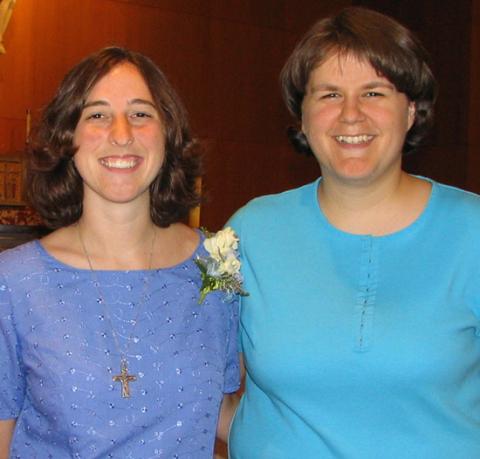
Sally Clark (then Sr. Maria Sally Willitzer), left, stands next to childhood friend, Sr. Jennifer Marie Zimmerman, a Sister of Notre Dame, on the occasion of Clark's reception as a novice in 2004 in Toledo, Ohio. (Provided photo)
Friends since age 3
Now and then a friendship precedes entering a religious community, and endures well after the break is made.
Sr. Jennifer (she goes by "Jenny") Marie Zimmerman, a Sister of Notre Dame, has been close friends with Sally Clark (then Willitzer) since they were youngsters growing up together in Defiance, Ohio.
In one of these you-can't-make-this-stuff-up twists, it was Willitzer who, in 2001, entered the religious community first. It was through her that Zimmerman got to know the Sisters of Notre Dame and its regional convent in Toledo, Ohio.
After eight years with the sisters, said Clark, she didn't feel settled. "I was kind of angry for no particular reason and had been feeling that way for a couple of years." One day, in the parish where she was serving, it became clear: What she was doing was good, she knew, but it wasn't for her.
Though they were not living in the same convent at the time, Zimmerman could tell, she said, that her friend was not completely happy, and wasn't surprised when Clark told her she was leaving.
The summer after her vows expired, Clark met her future husband. He proposed in October, and they were married the next May.
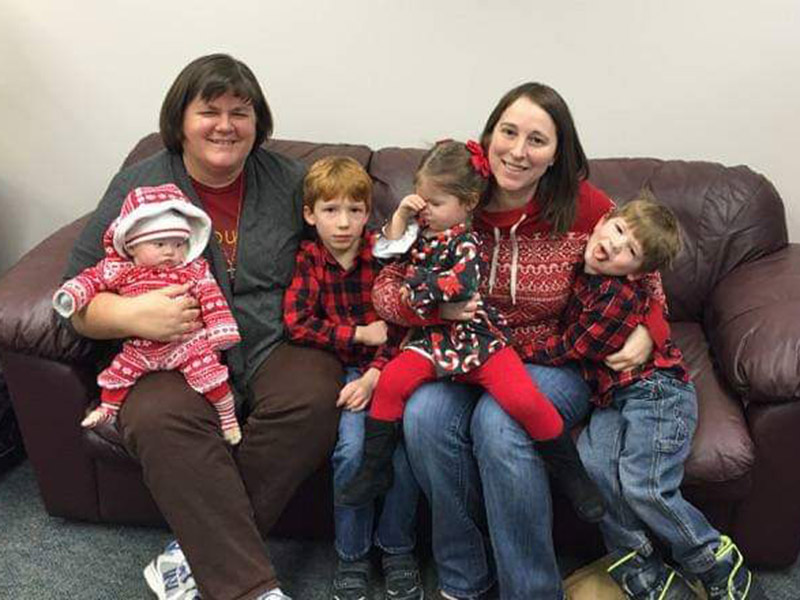
In this photo from 2017, Sr. Jennifer Marie Zimmerman, left, is holding former sister Sally Clark's baby daughter, Lucy, while eldest, Franklin (6 at the time), rests on her knee. Clark's daughter (and Zimmerman's goddaughter) Clara and son George also sit on the couch at Sr. Jennifer's then home in Toledo, Ohio. (Provided photo)
Now the national vocations director for her order, Zimmerman said that Clark's decision made her take a "hard look" at her own choice, reaffirming it. "One of the things I tell people is that's the whole point of formation and of discernment. Sally's discernment was just as successful as mine."
Now the mother of four young children, Clark, who works as a director of Christian education at a parish in Milan, Ohio, stays in touch with five or six sisters in her old community, returning for celebrations, funerals, and of course, for Sr. Jenny's final vows.
"We've been friends since we were 3. It's not like I'm not going to see her again," said Zimmerman.
Reconnecting with your religious community is in part about reestablishing the bonds of one's youth, said La Salle professor McGuinness. "It's really about relationships, not about stigma, or making a right or wrong decision."
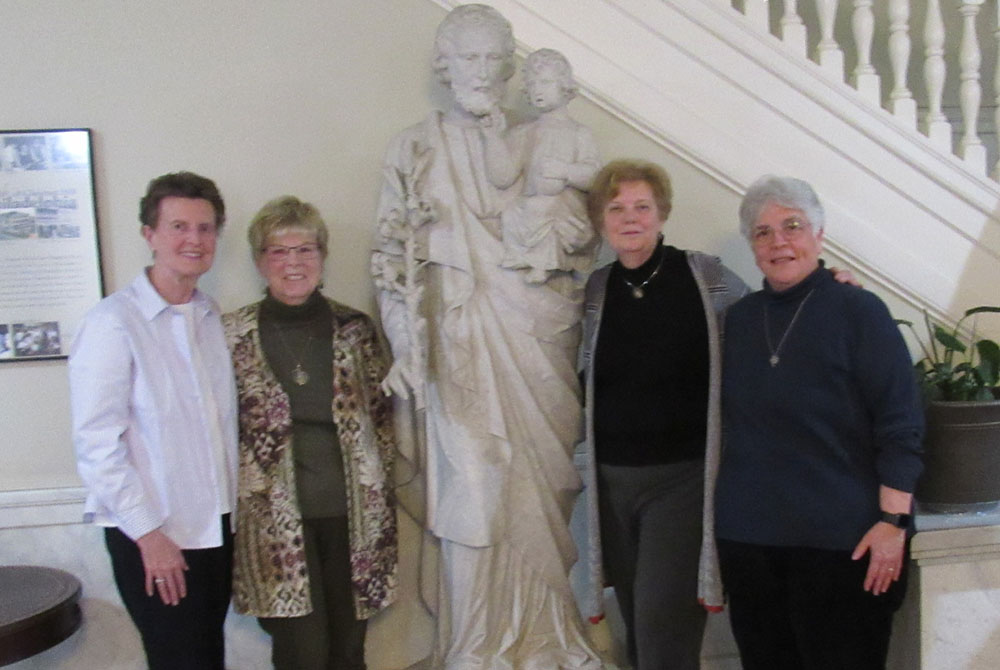
Sr. Marjorie Lawless, left, stands next to friend and former sister Cathy O'Brien by the statue of St. Joseph in the hallway of the motherhouse in Chestnut Hill, Philadelphia. At right of the statue are former sister Mary Jo Dagney and friend Sr. Rose Reda. (Elizabeth Eisenstadt Evans)
In June the Sisters of St. Joseph were planning to invite former members back for a big reunion. The get-together has been canceled, due to the novel coronavirus, and will be rescheduled at some point, said Lawless.
More than 20 years ago, in their first formal gathering, said Reda, the superior at the time got up in front of sisters and former sisters and apologized for any hurt that might have occurred as they left. "It was a powerful experience and a good one," she said.
It's clear that she looks forward to the canasta group get-togethers at Dagney's apartment, and not just because Dagney is rumored to be an excellent cook.
"This is a very enclosed environment," said Reda. "Our lives are probably much richer because of these different relationships."
Advertisement
Known as "the glue" or "the wedding planner," Lawless organized O'Brien's first nuptials (she has since been widowed and remarried), and those of another friend, also a former sister.
After their conversation in the chapel was over, the women walked out, pulling out their cellphones to commemorate the occasion with photos.
"Once a Sister of St. Joseph, always a Sister of St. Joseph," said Lawless. They pose next to the hallway statue of the saint himself before going on their separate ways.
[Elizabeth Eisenstadt Evans is a freelance writer specializing in religion coverage. She is a frequent contributor to Global Sisters Report.]







